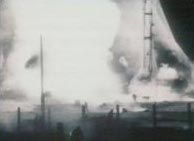Nedelin catastrophe

The explosion
|
|
| Native name | Катастрофа на космодроме Байконур |
|---|---|
| English name | The Catastrophe at Baikonur Cosmodrome |
| Time | 18:45 |
| Date | October 24, 1960 |
| Venue | Baikonur Cosmodrome |
| Location |
|
| Also known as | Nedelin disaster |
| Type | Rocket explosion |
| Cause | Short circuit in the rocket |
| Organised by | Soviet Strategic Missile Troops |
| 120 injured | |
| Deaths | 78 (92-126 from other sources) |
The Nedelin catastrophe or Nedelin disaster was a launch pad accident that occurred on 24 October 1960 at Baikonur test range (of which Baikonur Cosmodrome is a part), during the development of the Soviet ICBM R-16. As a prototype of the missile was being prepared for a test flight, an explosion occurred when second stage engines ignited accidentally, killing many military and technical personnel working on the preparations. Despite the magnitude of the disaster, news of it was suppressed for many years and the Soviet government did not acknowledge the event until 1989. The disaster is named after Chief Marshal of Artillery Mitrofan Ivanovich Nedelin (Russian: Митрофан Иванович Неделин), who was killed in the explosion. As commanding officer of the Soviet Union's Strategic Rocket Forces, Nedelin was head of the R-16 development program.
On 23 October, the prototype R-16 was installed on launching pad 41 (Russian: стартовая позиция 41) awaiting final tests before launch. The missile was over 30 m long, 3.0 m in diameter and had a launch weight of 141 tons. The rocket was fueled with Devil's Venom — hypergolic UDMH as the fuel and a saturated solution of dinitrogen tetroxide in nitric acid as the oxidizer — which was used because of the high boiling temperatures and hence storability of the fuel and oxidizer despite being extremely corrosive and toxic. These risks were accounted for in the safety requirements of the launch procedures, but Nedelin's insistence on performing tests before November 7 (anniversary of the Bolshevik Revolution) resulted in extreme schedule pressure, with numerous safety procedures being ignored in order to save time.
...
Wikipedia
